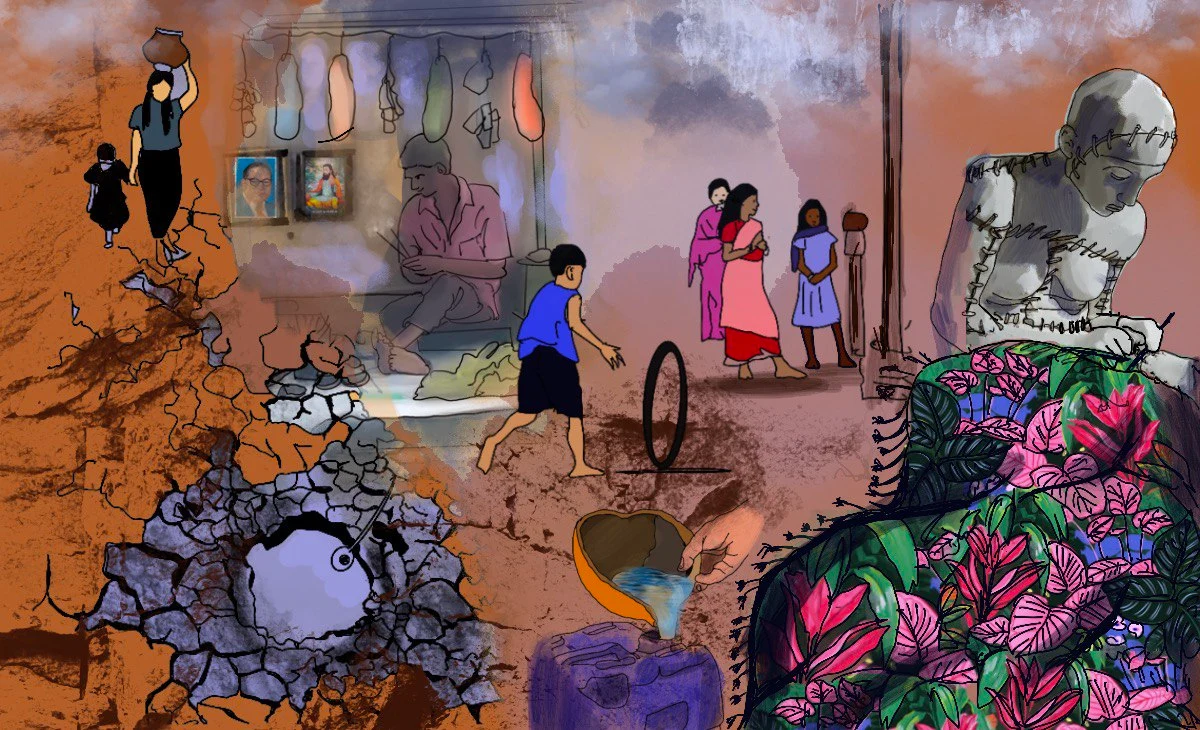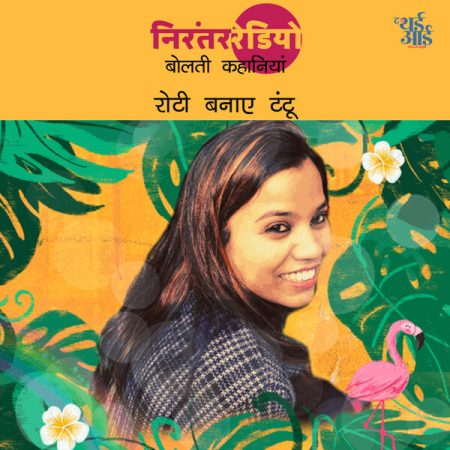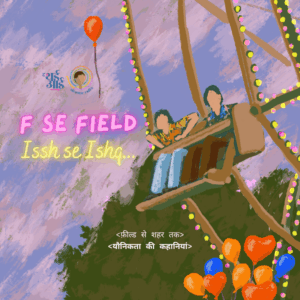Along with an excerpt from Mukul Sharma’s book (published concurrently here in our City Edition), this interview reimagines the contours of the city. Mukul offers us an alternate history of Chandigarh through Nek Chand’s contribution to it, and positions Dalit eco-narratives as a lens to widen the scope of environmental justice.
TTE: Can you tell us a little bit about your research background and how that led to your book Dalit Ecologies?
Mukul: I define my environmental research background in three broad fields that certainly overlap at times: political ecology, social ecology and environmental conflicts.
Political ecology forges links with gender studies and social movement analyses. It attempts to provide both critiques and alternatives in this interplay of the environment and political factors — to represent an alternative to apolitical ecology. This is the framework in which I place my book Green and Saffron (republished 2024).
Social ecology, for me, suggests that the roots of current ecological and social issues can be traced to hierarchical modes of social organisation. It locates the roots of these ecological issues firmly in relations of hierarchy and domination between people: “The very notion of the domination of nature by man stems from the very real domination of human by human.”
This is the basis of my books Caste and Nature (2017) and Dalit Ecologies (2024). My earlier work focussed more on the interrelationship between caste and nature, and how Dalits see environment differently and distinctly.
In Dalit Ecologies I wanted to extend research areas to rural and urban environments; industrial, technological and agricultural systems; developmental and anthropogenic activities; and economic, political, cultural and climate change spheres through the lens of Dalit thought and Dalit social and political organisations.
TTE: ‘Ecology’ has a versatile usage in this book, signifying space, place, labour, memory, violence, even a system of unequal relations — not just the environment and nature as we know it. What does ecology mean through the caste lens?
Mukul: Caste and nature are intimately and inextricably interwoven in India; Dalit experiences and narratives constantly underline their everyday ecological burdens in a marked hierarchal order.
Images of land animate caste anxieties around labour, blood and bondage.
In dry regions, Dalits must often sacrifice their lives to recharge ponds and water resources.
From village to city and temple to school, caste metaphors of pollution, impurity and dirt dominate places and spaces, through imaginaries of dangers posed by the presence of Dalits.
Forests can be a haven or a hell for Dalits. A river is someplace to dispose your body. Nature, entwined with fear and violence, horror and hardship, bloodbath and war, makes environmental experiences of Dalits distinctive and different. Landless Dalit agricultural labourers in Kerala have, for example, such memories of forest, animal, wood and weather in their songs:
Collecting wood in the forest
Wild animals accost us
The weather is against us!
At the same time, Dalit eco-experiences have their own vibrancy and dynamism. Living with nature, they are constantly negotiating with — and challenging — caste domination, while simultaneously articulating their environmental imagination. Dalit thinkers and contemporary excavations of Dalit memory create varied and alternative spatial and social metaphors around the environment.
The songs and narratives of early bonded labourers; writings by leading Dalit ideologues, leaders and writers; myths, memories and metaphors of Dalits around nature; their movements, labour and footsteps (including those in research) highlight Dalits’ attempts at defining themselves in caste-ised nature through heterogeneous means.
TTE: In ecological narratives, knowledge is often taken as evidence of a crisis, an exposure to an unheard reality. What makes Dalit narratives more active than that?
Mukul: In Dalits’ ecological narratives, there are several instances of agitations and agency; Dalits have a rich and diverse environmental history and sensibility. They have a distinct environmental memory and language. Their relationship to the environment manifests through regular collaboration and conflict with Brahmin-dominated eco-space, as well as in creation of their autonomous space.
It is also true that Dalits have generally articulated this language under the rubric of ‘social’, as opposed to explicitly ‘environmental’; at times expressed more from the margin than the mainstream, from the local than the national — raw, rather than refined.
Dalit voices enlarge and enrich our environmental imagination. There is a wealth of Dalit eco-literature — poems, paintings, stories, music, and folklore — from diverse regions and communities. Dalit myths and legends of Mayabel and Jasma, or Deena and Bhadri underline their dreams and desires for ecological belongings, as against their suffering, sacrifice and alienation. [Dalit eco-literature has its own] gods and goddesses, pujas and festivals — Kattamaisamma (discoverer of the tank system and goddess of water), Potaraju (protector of soil and fields), Yandi (marvel of technological knowledge), Nuakhai, Dalkhai, Duma and Maati Devi — to celebrate and highlight their ecological capacity and connectivity to natural elements, against all odds.
Dalits are active ecological agents in their own right, and their understanding of nature and ethics, planning and management of resources, labour and environment, is intertwined with narratives of social justice.
TTE: What place do narratives hold, as a methodological and symbolic tool, in your work? What might your chapter on Nek Chand’s Rock Garden do for a reader?
Mukul: Narratives are central to my research, both methodologically and symbolically, especially in the project of reimagining a Dalit Anthropocene. In Dalit Ecologies, I take ‘life narratives’ — stories, testimonies, songs, oral histories, visual art and memories — as foundational materials through which we can understand not just environmental injustices, but also the ways in which Dalit communities negotiate, survive and resist these injustices on a daily basis.
These narratives are not simply records of suffering or marginality. [Dalit narratives] are active meaning-making processes, full of agency, imagination and historical depth.
As a methodological tool, narrative allows me to access and foreground the subjective experiences of Dalits in environmental contexts — experiences that are often rendered invisible in mainstream ecological discourses.
Stories emerge from forests, rivers, fields, cities, industries and technologies, and from the bodies and labour of people who live at the sharp edges of caste and ecological violence.
Dalit narratives are thick with ecological content — charged with emotions, metaphors, and sensory memory — that resist being reduced to statistical data or apolitical environmentalism.
I see narratives as deeply allegorical, carrying collective histories and aspirations of communities denied land, water, place and space. These allegories enable us to grasp the intimate intertwining of caste and nature.
In [the chapter on] Nek Chand, I examine how Dalit Bahujans create alternative spatial and ecological imaginaries: making place out of displacement, commons out of exclusion and identity out of erasure. These are not just symbolic acts; they are acts of world-making, of asserting ecological belonging and agency.
In this sense, narratives are not simply tools of documentation but are part of the struggle itself. They help build what I call a Dalit Anthropocene — a framing that brings caste to the centre of our understanding of human-environment relations in the present epoch.
The Anthropocene, as it is usually told, is a universal story of planetary change. But Nek Chand narratives challenge that universalism. They ask: Whose Anthropocene? Whose environmental crisis?
To work with Dalit life narratives is thus to engage with a different kind of environmental archive — one rooted in oral cultures, social memory, cultural practices and embodied knowledge. It is also to foreground folk and language voices and epistemologies that have been systemically excluded. In doing so, these narratives become both witness and intervention, archive and future — tools not only to understand the world, but to reimagine and remake it.
TTE: Can you talk a little bit about the fieldwork you did for this book?
Mukul: The fieldwork for Dalit Ecologies was immersive, interdisciplinary, and deeply dialogic. It unfolded over several years and across six northern and western Indian states — Delhi, Uttar Pradesh, Haryana, Rajasthan, Gujarat and Maharashtra — where I travelled extensively through villages, cities, industrial zones and semi-urban peripheries.
It was not a one-time survey, but an evolving, long-term engagement. I interacted with Dalit communities and met with Dalit organisations, activists, writers, and cultural practitioners — many of whom had been working for years on issues of land, livelihood, dignity and ecological injustice.
What shaped the fieldwork most powerfully was not just the sites I visited or the people I interviewed, but the ecological textures of everyday Dalit life — the rhythms, smells, sounds, and affect of caste-marked spaces. I drew deeply from everyday ecological narratives: folktales passed on in villages, protest songs sung during rallies, ritual performances, memory archives, local art, wall paintings, plays and deeply embodied forms of labour.
I was welcomed into homes where texts were kept in cloth, where people recited myths of gods like Kattamaisamma or Potaraju — deities who protect tanks, soil and forests but are rarely acknowledged in mainstream ecological discourse. These encounters, with archives that do not sit in libraries, revealed how Dalits have developed a complex environmental sensibility from their marginalisation.
This layered approach — blending oral histories, local literatures, social and political activism, sensory engagement and visual observation — helped me understand ecology not merely as ‘nature’, but as caste-marked space, as struggle, as violence and as resistance. I wasn’t collecting data in a traditional sense; I was listening to the world’s local languages, histories and ways of being that are often erased from environmental studies.
Crucially, fieldwork meant unlearning elite narratives of sustainability, abstract models of environmentalism and universalist frames of the Anthropocene.
It required being present in places that smell of decay and leather, where the air is thick with toxins, where fields are bone-dry or over extracted and where dignity is constantly negotiated. It was in these spaces that I began to grasp the meaning of Dalit ecologies — lived, struggled, and imagined.
TTE: How does the Dalit articulation of environmental justice change the way we understand what an environmental struggle is? What should we centre, when we ask for environmental justice?
Mukul: Dalit livelihood issues and rights have been prominent during the past two decades, in the context of conservation, pollution, extraction of raw materials, alterations of ecosystems, environmental degradation, resource pricing and marketing, impact of climate change and the making of environmental policy.
However, Dalit estrangement goes much deeper; their detachment from mainstream environmental movements continues, in spite of their increased access and participation in the recent past.
A recognition of caste, and the deep natural, social and cultural processes involved in the making and unmaking of touch, taste, smell and senses in a caste society, which crushes people’s sense of freedom and belonging and devalues their use, access and participation in naturescape, can take us towards a richer understanding of environmental justice. Focusing on Dalits as subjects — and the everyday social processes of construction of their environmental subjectivity — can open up new possibilities of their agency.
In my new work, I argue for a new environment justice vocabulary — one that integrates sensory and social dimensions to address the entangled relationships between environment, power and lived experience in caste-based societies.
TTE: You draw on Dalit literature (mainly autobiographies) and folktales in your methodology, breaking from conventional research methods. How do these complicate and resist scholarly articulations of the Anthropocene?
Mukul: Dalit autobiographies, folktales and oral histories offer an alternative archive that powerfully resists dominant scholarly articulations of the Anthropocene. Most academic accounts of the Anthropocene are framed within universalist and technocratic paradigms. They often focus on climate data, industrial systems, and human-on-human entanglements at a planetary scale, assuming a shared humanity as the cause and victim of ecological degradation.
This universal ‘human’ flattens histories of caste, race and inequality. It ignores the fact that not all humans have contributed equally to environmental harm, nor are they equally affected by it. Dalit narratives disturb this universality.
They refuse to be folded into a generalised Anthropocene story without addressing the violence of caste and its ecological consequences.
What autobiographies and folktales did, methodologically, was to decentralise theory and prioritise lived experience. Through visceral, affective and embodied accounts of landlessness, pollution, labour and survival, Dalit narratives expose how caste hierarchies are embedded in environmental practices and policies.
These stories are not mere supplements to scholarly knowledge; they produce knowledge.
They refuse the epistemological distancing of academic environmentalism. Instead of abstract categories like ‘climate risk’ or ‘ecological footprint’, they give us images of people dragging carcasses, inhaling toxic fumes in leather units, working in the hottest sun without shade or protection, or being denied access to clean water on account of caste impurity.
They draw our attention to the sensorium of inequality — the smells, sounds, textures and tastes of caste oppression in ecological settings.
TTE: How did Dalit visual frameworks interact with your research?
Mukul: They complicate the visual frameworks through which the Anthropocene is usually imagined. Scholarly literature often relies on satellite imagery, graphs or climate maps — tools that render environmental changes legible at macro scales.
In contrast, Nek Chand’s Rock Garden produced grounded, thick and symbolic representations of ecological life. He showed how caste, waste and city work through aesthetics: through what is seen and unseen, clean and unclean, sacred and profane.
More importantly, [these visual frameworks] imagine different futures. The visuals and metaphors in Nek Chand’s Rock Garden are not always about pain; they are also about world-making. His stories create an affective cartography of justice, pointing towards alternative environmental imaginaries rooted in equality, access and dignity.
Dalit literature and folklore act not only as sources, but as theoretical interventions.
They question who gets to define the ecological crisis, what counts as knowledge and whose bodies and spaces matter. They enable a move from the Anthropocene to a caste-marked Anthropocene — what I call a Dalit Anthropocene — anchored in the specificity of pain, place, power and possibility.
TTE: What are some of the tensions between the anti-caste movement and the environmental justice movement?
Mukul: Perhaps the most important is the near-complete absence of caste as a category in understanding environmental injustice: what I call the ‘caste blindness’ of environmental justice politics. This is the failure to recognise Dalits as Dalits. In contrast, anti-caste movements demand that caste and Dalits be recognised within environmental politics.
The discourse on environmental discourse in India often draws on the glory of India’s past — its religion, tradition, culture and community. Dalits and anti-caste movements see these [glories] differently.
Compare the views of leading environmental scholars and writers with those of anti-caste thinkers and activists on the idea of community, of the village. The differences are striking — they stand on opposite sides. It baffles me that environmental justice discourse has failed to acknowledge the lived experiences and perspectives of Dalits and lower-caste people when it comes to village life and community.
Environmental justice movements in India have often been highly critical of science, technology, industry and development, sometimes rejecting them outright. However, their ideas about alternative development, people’s science or appropriate technology are not connected to Dalit lives or aspirations.
In contrast, Dalits and anti-caste movements have been more engaged [with science]. They see science, industry and technology as opportunities for progress — tools to break free from caste-based occupations and social positions. Even the language of environmental justice in India is too limited. Its images, examples, deities and memories do not reflect the richness and depth of anti-caste traditions.
-
Mukul Sharma is a professor of environmental studies at Ashoka University, India. He has published Caste and Nature: Dalits and Indian Environmental Politics (2017), Defining Dignity: An Anthology of Dreams, Hopes and Struggles (ed., 2005), and Unquiet World: Dalit Voices and Visions (ed., 2004). He has worked in media and civil society organisations and was associated with World Social Forum, World Dignity Forum, and National Confederation of Dalit Organisations.





